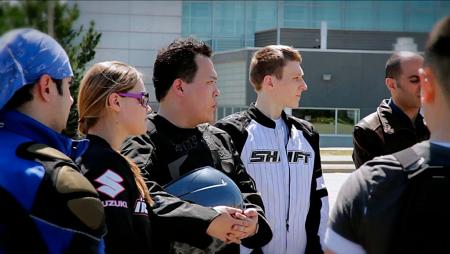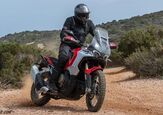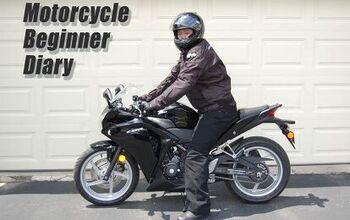Motorcycle Beginner: Rider Training
The first thing I noticed after I hit the ground was the sound of raindrops hitting the back of my helmet.
My visor had popped loose from bouncing off the hard knuckle protectors on the back of my gloves after I had raised my hands to cushion the landing. Cool air blew into the opening while a drop of sweat dripped from my nose and landed on the rain-soaked pavement.
My arms and legs felt relaxed and comfortable, as lying face down on the wet parking lot pavement gave my strained muscles a rare opportunity to rest after two long days of riding. A dull throbbing, however, alerted that something was wrong with my right ankle.
I then heard the footsteps of the instructors rushing over to me, followed by shouts telling me not to try to move.
But one thought remained clear in my head, like a flashing neon sign in my mind’s eye: I had just failed my rider training course exam. The worst part of it was I knew exactly what I did wrong. In fact, one of the first things the instructors warned us against doing.
Three Days Earlier …
“Remember, be gentle with the front brake,” said Lenny Mammoliti, a coordinating instructor of the Humber College Motorcycle Rider Training Program. “Don’t grab it. Gently squeeze the brake lever.”
Mammoliti held his arm up in front of him and demonstrated how to slowly curl your fingers when applying the front brake. He was speaking to a roomful of about 60 students enrolled in the school’s Gearing Up training course. Certified by the Canada Safety Council, the program is designed for new riders with little or no experience on a motorcycle, similar to the Motorcycle Safety Foundation’s Basic RiderCourse.
Almost all of the students in the class, myself included, have what is called an M1 class license in Ontario. Earned by passing a motorcycle and road knowledge test, the M1 license lets someone ride a motorcycle or scooter under certain conditions. M1 license holders must have a blood alcohol level of zero when riding, they may only ride during daylight hours, they are not allowed on most highways with a speed limit over 80 kph (50 mph) and they may not carry passengers.
Passing the Gearing Up course means you are exempted from the government’s M1 road test and can upgrade to an M2 license 60 days after earning your M1. More importantly perhaps, you also get a certificate that can help you receive discounts on insurance.
The students represented a wide mix of age groups and ethnicities, though the gender balance was noticeably swaying more towards the men. Andy Hertel, program manager and chief instructor tells me women usually make up about 25% of students, still a minority, but a growing one. A lot of students are also what Hertel calls “returning riders,” those who have ridden motorcycles in the past, but haven’t ridden in quite some time and wanted a refresher.
The program sees about 2,100 to 2,200 students enroll each year. About 90% of the students in the Humber College Motorcycle Rider Training Course complete the test and pass the program. Another 5% decide part way in that motorcycle riding isn’t for them, and walk away. The rest? Andy doesn’t like to use the word “fail.”
“Even if they don’t pass the test, they still come away knowing more about riding than they did before,” Hertel said. “They may not have passed the test, but I’d still call that a success.”
The classroom session took place on a Thursday evening with two days of riding over the ensuing weekend. The classroom time provided an overview of the program, a discussion about riding gear and a couple of videos produced by the MSF. The information covered was pretty straight-forward and reinforced what I read in preparing for the knowledge test. Lenny’s instruction gave that knowledge some added context and he was able to answer any questions students raised. More importantly, Lenny set a positive, upbeat tone to help settle everyone’s nerves.
A lot of other students had questions about what riding gear they needed for the program, but I knew I was prepared thanks to my shopping spree earlier. A bigger concern for me was the weather forecast calling for rain over the weekend.
Lessons Learned the Hard Way |
Within every mistake is a lesson to be learned. In this series of sidebars, the Motorcycle.com staff shares stories about our early two-wheel blunders and what we learned from them. This exercise in poor judgment happened during the early years of my motorcycling career when the thrill of riding muddied clear thinking.Tim, on his 1987 Suzuki GSX-R1100, easily passed the slow moving car in the short distance before the approaching right turn. I, on my 1981 Honda CX500 Custom, did not. By the time I got around the front of the automobile I was practically in the corner. I don’t remember exactly what happened next, whether I grabbed too much front brake or simply laid the bike down from scared inexperience, but the result was me and the bike in a heap on the ground. Because the driver of the automobile came to a quick stop and there was no on-coming traffic, the result of my foolhardy pass was nothing more than a slow-speed crash from which I walked away from with nary a scratch. What I do remember is the embarrassment of having to pick up and remount the motorcycle while the folks in the car I had just precariously passed waited and glared. We never spoke, but their facial expressions said everything: “What were you thinking!?!” The moral this event illustrates is to “Ride Your Own Ride,” and it should be a lesson you don’t need to crash to learn. Be patient, your riding buddies will wait for you to catch up. - Tom Roderick, Content Editor |
First Ride
The skies were clear when I arrived at the Humber College parking lot for the first day of riding. Like me, most students drove to the campus, but there were quite a few who rode their own motorcycles. Some students have obviously had some experience riding, but as Lenny had told us earlier, we should focus on learning at our own pace and not worry about how other students are doing.
The morning air was soon filled with the roar of V-Twin engines as instructors rolled out a fleet of training bikes. The Humber College program uses modified Yamaha Virago 250 cruisers. Now known as the V-Star 250, the Virago 250 is a lightweight cruiser with a low 27-inch seat height and feet forward riding position. The bikes had some modifications: lights, mirrors and speedometers had been removed and some were equipped with straight dirt bike style handlebars instead of the stock handlebars.
After a brief introduction, students were broken up into groups of ten, each group led by two or three instructors. Once the groups were organized, we headed to a row of training bikes lined up along a curb. I climbed onto my Virago and got a sense of the controls. At six-feet tall, I found the Virago to be a little uncomfortable at first as my knees and elbows seemed awfully close to each other. I started getting used to it after a while, though smaller riders probably found it easier.
The first few exercises involved a lot of pushing as we took turns “riding” while other students pushed us along. Under human-powered propulsion, we practiced balancing on the bikes and making low-speed turns. Just as we started to get tired of all the pushing, it was finally time to get the motors running and start riding for real.
My first few attempts were rather tentative. We rode at very slow speeds as we focused on controlling the clutch and modulating its friction zone. I stalled a couple of times before I understood it was okay to rev the engine more if I used the clutch to control my speed.
Staying at low speeds, we practiced turning, weaving around pylons and coming to a stop. By the time we stopped for a break, I could feel my left forearm cramping from squeezing the clutch lever most of the morning.
As the day continued, we moved on to higher speed exercises and shifting up to second and sometimes third gear. The instructors maintained a positive attitude, celebrating our successes and cheering us on while keeping an eye out for bad habits like not checking over your shoulder before you start to move or forgetting to downshift to first gear after coming to a stop.
One of my bad habits was not keeping my eyes up high enough. I was used to keeping my vision at a certain level when driving in my car, and I thought I was doing a good job of keeping my eyes up, but the instructors helped me realize I wasn’t looking high enough.
The first day ended and I was physically spent. After spending more than seven hours on a motorcycle, my body ached from performing exercises my muscles weren’t used to yet. Before we left, Lenny gathered all the students together for a pep talk and we were told to go home and get a good night’s sleep because we had another long day ahead of us.
| Lessons Learned the Hard Way |
The first time I hit the ground on a motorcycle I was 19 and had only been riding less than six months. A group of my riding buddies decided to go to the local canyons, and having just purchased my dream bike — a Suzuki SV650S — I was eager to see how it would perform. Having just purchased my first set of leathers, I felt I was finally ready to get a little more aggressive. We went up the canyon road a few times but I felt I could go faster, so as the group took a rest at a turnout, I decided to do a few more passes. Coming down the hill, as I came to the bend where my friends were waiting, one of them waved their hands to warn me of trouble ahead — right as I started turning in. At that point I panicked, picked the bike up and ran off the road through a big turnout. But I was scared to use the front brake for fear of locking it up, and I instead jammed the rear brake and locked it. I stayed upright with the rear skidding down the road, but when the edge of the cliff came approaching fast, I decided to abandon ship and lay her down. Thankfully the bike stopped in time and the frame sliders took most the damage. When I explained why I didn’t use the front brake, one of my more experienced friends showed me just how much stopping power is available in the front by doing multiple panic stops. Then he had me do some. At that point I realized I could have easily stopped my bike in time if I had just practiced panic stops before and felt comfortable utilizing the front brake. Now that I commute regularly in Los Angeles on two wheels, that lesson has proven to be invaluable. - Troy Siahaan, Associate Editor |
More by Dennis Chung














![Marisa Miller Takes Harley-Davidson Rider's Edge Training [Video]](https://cdn-fastly.motorcycle.com/media/2023/05/07/11556202/marisa-miller-takes-harley-davidson-rider-s-edge-training-video.jpg?size=350x220)















Comments
Join the conversation